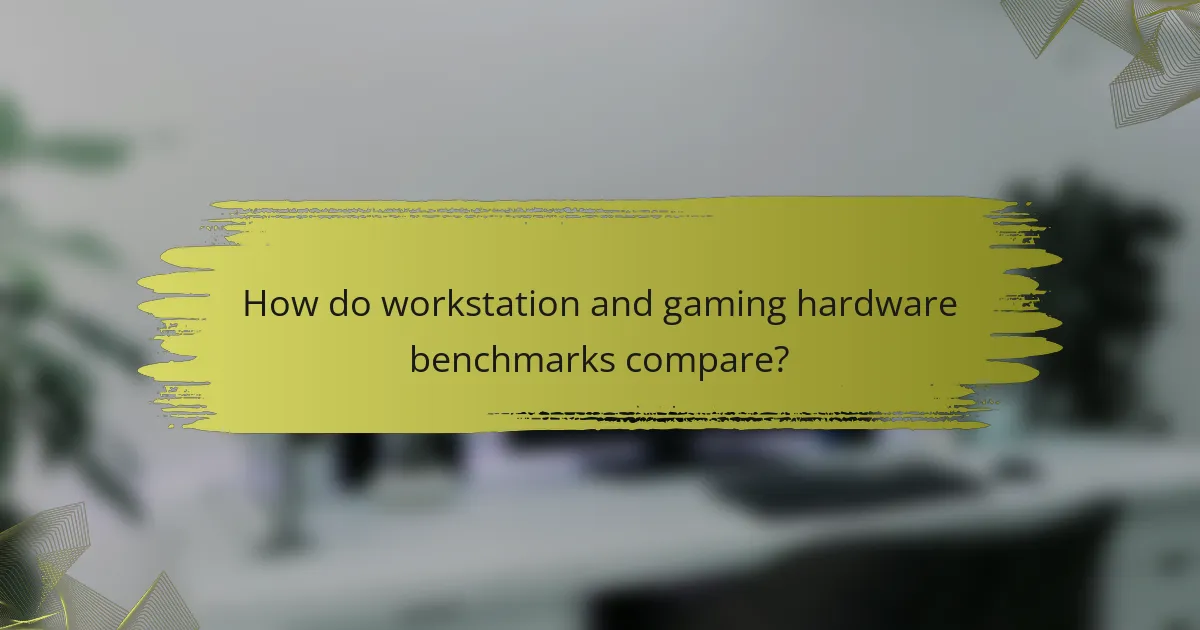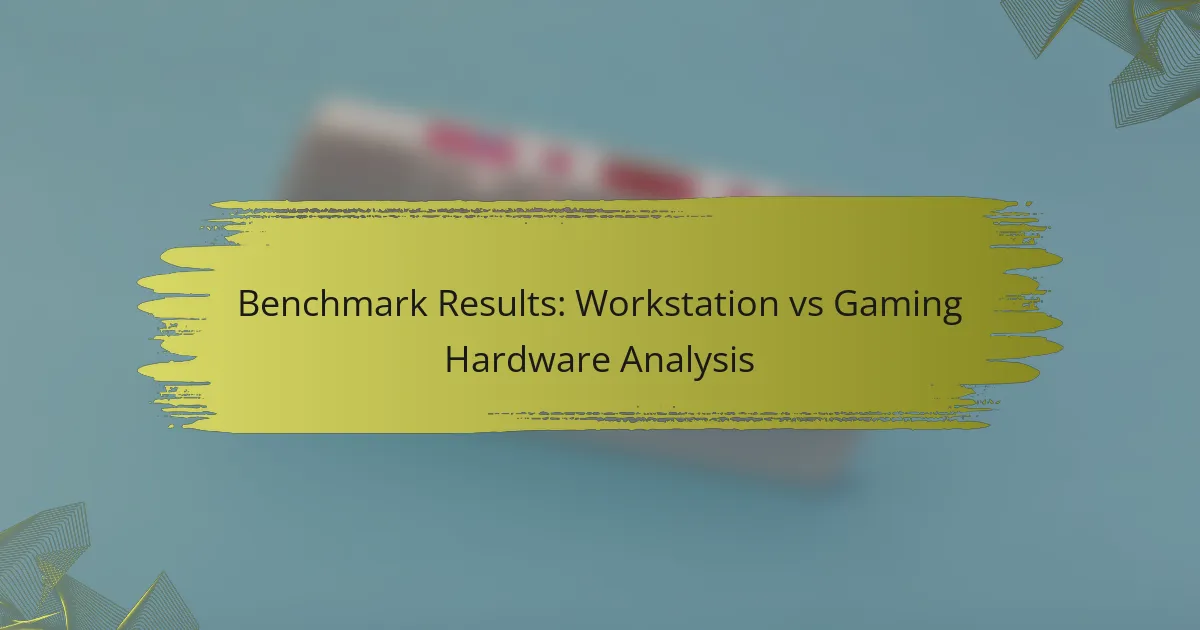This analysis delves into the benchmark results of workstation versus gaming hardware, highlighting their distinct performance metrics and optimization focuses. While workstations are designed for precision and reliability in professional tasks, gaming hardware emphasizes speed and graphical capabilities for an immersive gaming experience.

How do workstation and gaming hardware benchmarks compare?
Workstation and gaming hardware benchmarks differ significantly in their focus and performance metrics. Workstations are optimized for tasks requiring high precision and reliability, while gaming hardware prioritizes speed and graphical performance.
Performance metrics overview
Performance metrics for workstation and gaming hardware typically include processing power, graphics capabilities, memory bandwidth, and storage speed. Workstations often excel in multi-threaded applications and large data handling, whereas gaming systems focus on frame rates and rendering quality.
Benchmarks like SPEC CPU for workstations and 3DMark for gaming provide insights into how each type of hardware performs under specific conditions. Understanding these metrics helps users choose the right hardware for their needs.
Key differences in benchmarks
One key difference in benchmarks is the emphasis on stability and accuracy in workstation hardware versus the speed and responsiveness in gaming setups. Workstations may score higher in tasks involving complex calculations, while gaming hardware often achieves better results in graphics-intensive scenarios.
For example, a workstation might perform exceptionally well in CAD applications, achieving high scores in tasks that require detailed rendering, while a gaming system will likely outperform it in 3D gaming benchmarks, focusing on frame rates and visual fidelity.
Real-world application results
In real-world applications, the choice between workstation and gaming hardware can significantly impact productivity and performance. A workstation is ideal for professionals in fields like engineering, video editing, or scientific research, where precision and reliability are crucial.
Conversely, gaming hardware is better suited for tasks that demand high-speed graphics processing, such as game development or 3D modeling. Users should assess their specific needs and consider how each type of hardware aligns with their performance requirements.

What are the best workstation hardware options?
The best workstation hardware options prioritize performance, reliability, and expandability for professional tasks. Key components include powerful CPUs, ample RAM, and high-quality GPUs tailored for productivity and design applications.
Top workstation brands
Leading workstation brands include Dell, HP, and Lenovo, known for their robust and customizable systems. These manufacturers offer a range of models catering to different professional needs, from graphic design to engineering simulations.
Apple is another notable brand, particularly for creative professionals who prefer macOS. Their Mac Pro line provides high-end performance and seamless integration with creative software.
Recommended workstation models
For high-performance needs, consider the Dell Precision 7000 series, which offers powerful Intel Xeon processors and NVIDIA Quadro GPUs. This model is ideal for 3D rendering and complex simulations.
The HP Z4 G4 workstation is another excellent choice, featuring a flexible configuration that supports both Intel and AMD processors, making it suitable for various applications. It also provides options for extensive storage and memory upgrades.
For those seeking a compact solution, the Lenovo ThinkStation P620 is a standout, equipped with AMD Ryzen Threadripper processors, delivering exceptional multi-threaded performance while maintaining a smaller footprint.

What are the best gaming hardware options?
The best gaming hardware options typically include high-performance graphics cards, powerful CPUs, and ample RAM to ensure smooth gameplay. When selecting gaming hardware, consider your budget, the types of games you play, and the desired performance level.
Leading gaming brands
Several brands dominate the gaming hardware market, known for their reliability and performance. NVIDIA and AMD are the top choices for graphics cards, while Intel and AMD also lead in CPU manufacturing. For peripherals, brands like Razer, Logitech, and Corsair offer high-quality gaming mice, keyboards, and headsets.
When choosing a brand, consider warranty options and customer support, as these can vary significantly. Additionally, look for user reviews to gauge real-world performance and reliability.
Popular gaming models
Some of the most popular gaming hardware models include the NVIDIA GeForce RTX 30 series and AMD Radeon RX 6000 series graphics cards, which deliver excellent performance for modern games. On the CPU side, the Intel Core i7 and AMD Ryzen 7 series are favored for their speed and multitasking capabilities.
For gaming monitors, models like the ASUS ROG Swift and Dell Alienware series are well-regarded for their high refresh rates and low response times. When selecting a model, ensure it meets your gaming needs, such as resolution and refresh rate, to enhance your overall experience.

How to choose between workstation and gaming hardware?
Choosing between workstation and gaming hardware depends on your specific needs and intended use. Workstations are optimized for tasks requiring high computational power and stability, while gaming hardware focuses on delivering high frame rates and immersive experiences.
Criteria for selection
When selecting between workstation and gaming hardware, consider factors such as performance requirements, software compatibility, and budget. Workstations typically feature powerful CPUs and GPUs designed for professional applications, while gaming setups prioritize graphics performance and speed.
Evaluate your workload: if you need to run resource-intensive applications like CAD software or video editing tools, a workstation is likely the better choice. For gaming or general use with occasional creative tasks, gaming hardware may suffice.
Use case scenarios
For professionals in fields like graphic design, 3D modeling, or scientific simulations, a workstation provides the necessary reliability and performance. These systems often support multi-threading and have larger memory capacities, making them ideal for demanding tasks.
Conversely, if your primary focus is gaming, a gaming rig will deliver the high refresh rates and graphical fidelity needed for an immersive experience. These setups are typically more cost-effective for gaming and can be upgraded easily to keep up with new titles.

What are the pricing differences?
The pricing differences between workstations and gaming hardware can be significant, often reflecting their intended use. Workstations typically range from moderate to high prices due to specialized components, while gaming rigs can vary widely based on performance needs and brand preferences.
Cost comparison of workstations
Workstations are generally priced higher than standard consumer PCs, often starting from around $1,500 and going up to $5,000 or more for high-end models. These systems are built for tasks requiring substantial processing power, such as 3D rendering or data analysis, which justifies their elevated costs.
When considering a workstation, factor in the cost of components like professional-grade GPUs, multi-core CPUs, and ECC RAM. These features enhance reliability and performance, making them essential for professional environments.
Cost comparison of gaming rigs
Gaming rigs can range from about $800 for entry-level systems to over $3,000 for high-performance setups. The price largely depends on the graphics card, processor, and additional features like RGB lighting and custom cooling solutions.
For gamers, it’s crucial to balance performance and budget. Mid-range gaming PCs typically offer good performance for most titles at reasonable prices, while high-end systems are better suited for demanding games at maximum settings. Avoid overspending on unnecessary features that do not enhance gaming performance.

What are the future trends in workstation and gaming hardware?
Future trends in workstation and gaming hardware indicate a convergence of technologies aimed at enhancing performance and user experience. Innovations such as AI integration, improved graphics capabilities, and more efficient cooling systems are expected to redefine both sectors.
Emerging technologies
Emerging technologies are significantly shaping the future of workstation and gaming hardware. For instance, the rise of AI-driven applications is pushing for more powerful GPUs and CPUs that can handle complex computations and real-time data processing. Additionally, advancements in ray tracing and virtual reality are enhancing visual fidelity, making gaming experiences more immersive.
Another notable trend is the development of cloud gaming and remote work solutions, which allow users to access high-performance hardware without the need for expensive local setups. This shift could democratize access to powerful computing resources, benefiting both gamers and professionals alike.
Market predictions
Market predictions suggest that the demand for high-performance hardware will continue to grow, driven by both gaming and professional applications. Analysts estimate that the global gaming hardware market could reach several billion USD in the coming years, reflecting a robust interest in advanced gaming setups and peripherals.
Workstation hardware is also expected to see significant growth, particularly in sectors like design, engineering, and data analysis. As remote work becomes more prevalent, companies may invest in high-quality workstations to ensure productivity and efficiency, potentially leading to a rise in sales for premium hardware brands.



